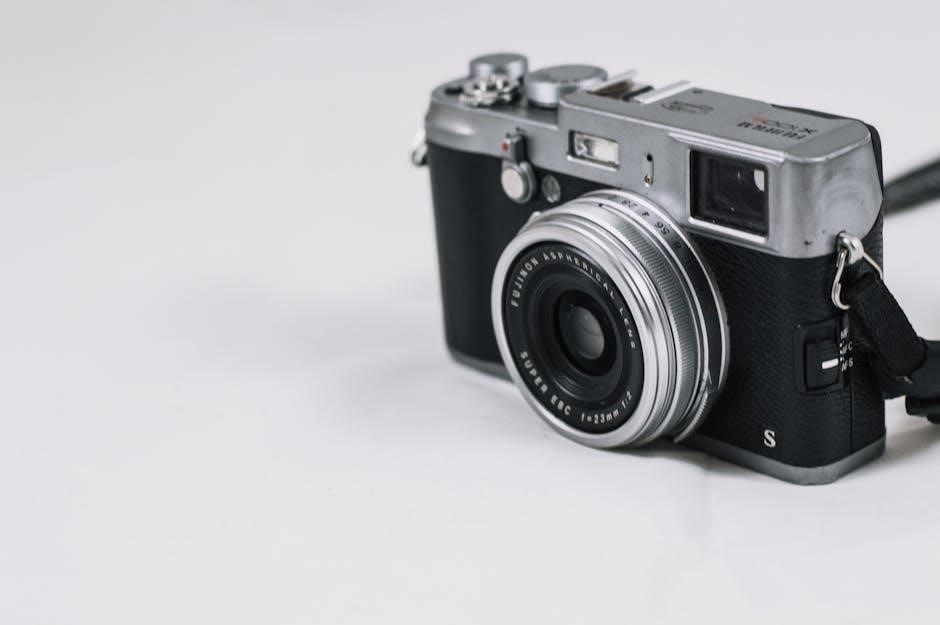manual lensometry
Summary
Master manual lensometry with our detailed guide. Learn precise measurement techniques and best practices for optical professionals.

Manual lensometry is the process of measuring the optical properties of lenses, such as spherical power, cylinder power, and prism power, using a manual lensometer. This method ensures accuracy and reliability in determining lens prescriptions for eyewear. It is widely used in opticianry and ophthalmology to verify the correctness of corrective lenses. Manual lensometers are preferred for their precision and control, especially when dealing with complex prescriptions.
1.1 Definition and Purpose
Manual lensometry is a precise method of measuring the optical properties of lenses, such as spherical power, cylinder power, axis, and prism power, using a manual lensometer. Its primary purpose is to verify the accuracy of lens prescriptions, ensuring they match the specifications provided by eye care professionals. This process is essential in opticianry and ophthalmology for dispensing corrective eyewear, as it guarantees that lenses meet the required standards for vision correction. Accurate measurements are critical for achieving optimal visual clarity and patient satisfaction.
1.2 Historical Background
Manual lensometry has its roots in early ophthalmology and opticianry, emerging as a crucial tool for measuring lens prescriptions. The first lensometers were developed in the late 19th century, relying on mechanical adjustments and visual alignment to determine optical properties. These early devices laid the groundwork for modern manual lensometers, which remain essential in verifying the accuracy of corrective lenses. The technique has evolved with advancements in optics but retains its fundamental principles, making it a cornerstone in eyewear dispensing and vision correction.

Types of Lensometers

Manual, automatic, and portable lensometers are the primary categories, each offering unique features like precision, automation, and portability for measuring lens properties efficiently.
2;1 Manual Lensometers
Manual lensometers are widely used for measuring the optical properties of lenses, offering precise control over adjustments. They operate via mechanical dials and knobs, requiring skill to align and focus the lens accurately. These devices are cost-effective and portable, making them ideal for opticianry and ophthalmology. Manual lensometers are preferred for their ability to measure spherical power, cylinder power, and axis, ensuring accurate prescription verification. They rely on the user’s expertise, emphasizing the importance of proper training for reliable results.
2.2 Automatic Lensometers
Automatic lensometers are advanced, digital devices that measure lens properties with high precision and speed. They utilize automated technologies to determine spherical power, cylinder power, axis, and prism power. These devices are ideal for high-volume settings, offering quick and accurate results. Automatic lensometers reduce human error and save time, making them popular in optometry and ophthalmology practices. They often feature touchscreens, memory storage, and connectivity options for data transfer, enhancing efficiency in clinical and industrial applications. Despite their higher cost, they are valued for their reliability and advanced functionality.

2.3 Portable Lensometers
Portable lensometers are compact, lightweight devices designed for measuring lens properties on the go. They are ideal for optometrists and opticians who need to conduct measurements outside traditional clinical settings. These devices are often battery-operated, making them suitable for fieldwork or remote locations. Portable lensometers combine ease of use with essential functionality, providing accurate measurements of spherical power, cylinder power, and axis. They are a practical choice for professionals requiring flexibility without compromising on precision, making them invaluable in various optical and industrial applications.
The Manual Lensometry Process
Manual lensometry involves measuring lens properties through precise alignment and adjustment. It requires preparing the lens, aligning it accurately, and using dials to measure spherical and cylinder power, ensuring accurate prescription verification.
3.1 Preparing the Lens for Measurement
Preparing the lens for measurement is crucial for accurate results. Start by cleaning the lens thoroughly with a soft cloth to remove dirt or smudges. Ensure the lens is dry, as moisture can distort readings. Position the lens on the lensometer stage, aligning its optical center with the device’s measurement axis. If the lens has a prism, orient it correctly based on the prescription. For bifocal or progressive lenses, focus on the specific area of interest. Use the lensometer’s blocking rings or a small pad to secure the lens firmly in place. Allow a few seconds for the lens to settle before proceeding. Proper preparation ensures precise and reliable measurements, avoiding errors caused by improper alignment or contamination.
3.2 Aligning the Lens in the Lensometer
Proper alignment of the lens in the lensometer is essential for accurate measurements. Place the lens on the stage, ensuring it is centered and secure. Adjust the stage height to match the lens’s optical center. Use the target reticle to guide alignment. Focus the eyepiece until the reticle is clear. Align the crosshairs with the lens’s center mark. Gently rotate the lens to position any prism correctly. Ensure the optical center is precisely aligned with the lensometer’s axis. Verify alignment accuracy before proceeding with measurements.
3.3 Measuring Spherical Power
Measuring spherical power determines the lens’s primary refractive strength. Focus the eyepiece on the target reticle, then adjust the power drum to align the crosshairs with the lens’s image. Start with a high plus setting to neutralize any astigmatism. Slowly rotate the drum until the red and green lines overlap, indicating the correct spherical power. Ensure the lens is centered and aligned properly before finalizing the measurement. This step is crucial for accurately determining the lens’s refractive correction, ensuring precise prescription verification.
3.4 Measuring Cylinder Power and Axis
Measuring cylinder power and axis corrects for astigmatism. After focusing the eyepiece on the reticle, adjust the cylinder drum to align the lines, ensuring they are straight and parallel. Use the axis wheel to rotate the drum until the lines align vertically or horizontally, indicating the correct axis. Proper alignment and focus are critical for accurate readings. This step ensures the lens’s astigmatism correction is precise, providing the correct cylindrical power and axis for the prescription, essential for clear vision correction.
3.5 Measuring Prism Power

Measuring prism power determines the lens’s ability to correct eye alignment issues like esophoria or exophoria. After focusing the eyepiece, align the reticle with the target to neutralize the prism. Adjust the prism drum until the image splits evenly, ensuring proper alignment. The prism power is read from the scale, indicating the amount of prism present. Accurate measurement ensures the lens corrects vision problems effectively. This step is crucial for aligning images between eyes, providing clear and balanced vision correction for individuals with specific prism prescriptions.
Practical Applications of Manual Lensometry
Manual lensometry is essential in opticianry, optometry, and ophthalmology for verifying lens prescriptions. It ensures accuracy in corrective eyewear and contact lenses, addressing refractive errors effectively.
4.1 Use in Opticianry
In opticianry, manual lensometry is crucial for ensuring eyewear meets prescribed specifications. Opticians use lensometers to measure spherical power, cylinder power, and axis, verifying lens accuracy. This process ensures that glasses or contact lenses correct vision precisely as intended. Additionally, manual lensometers help in detecting any discrepancies in prism power, which is vital for alignment and comfort. Regular use of manual lensometry in opticianry ensures high-quality, customized eyewear tailored to individual patient needs, enhancing visual clarity and patient satisfaction significantly.
4.2 Use in Optometry and Ophthalmology
In optometry and ophthalmology, manual lensometry is essential for precise measurement of corrective lenses. Optometrists use lensometers to verify prescriptions, ensuring accurate spherical power, cylinder power, and axis alignment. This is critical for diagnosing vision problems and prescribing corrective eyewear. Ophthalmologists also rely on manual lensometry to measure specialized lenses, such as those for aphakia or high myopia. The precision of manual lensometers aids in creating tailored solutions, improving patient outcomes and ensuring optimal vision correction in clinical settings.
4.3 Industrial Applications
Manual lensometry finds extensive use in industrial settings, particularly in quality control and the manufacturing of optical instruments. It ensures precise measurement of lenses used in cameras, telescopes, and microscopes. Industries rely on manual lensometers to verify the optical properties of specialized lenses, such as those with high refractive indices or unique coatings. This process is crucial for maintaining product reliability and performance. Additionally, manual lensometry supports research and development in optics, aiding in the creation of custom lenses for industrial automation and robotics, where vision systems require calibration and accuracy.

Tips for Accurate Manual Lensometry
Ensure precise measurements by calibrating the lensometer regularly. Use proper alignment techniques and maintain the instrument to prevent errors. Follow best practices for handling lenses and refer to user guides for optimal accuracy.
5.1 Importance of Calibration
Calibration is essential for ensuring the accuracy and reliability of manual lensometry measurements. Regular calibration prevents errors caused by mechanical wear or environmental factors. Proper calibration ensures the lensometer measures spherical power, cylinder power, and prism power accurately. It also maintains consistency across multiple measurements, which is critical for precise lens prescriptions. Calibration should be performed according to the manufacturer’s guidelines, typically before initial use and periodically thereafter. Accurate calibration guarantees reliable results, making it a cornerstone of effective manual lensometry practice.

5.2 Proper Alignment Techniques
Proper alignment is critical for accurate manual lensometry measurements. Begin by ensuring the lens is correctly positioned in the lensometer stage, with the optical center aligned to the instrument’s reticle. Adjust the stage height and rotation to match the lens’s orientation. Use the cylinder axis wheel to align the lens’s axes with the reticle. Proper alignment ensures precise measurement of spherical power, cylinder power, and prism power. Misalignment can lead to errors, making accurate results unattainable. Always double-check alignment before proceeding with measurements for reliable outcomes.
5.3 Handling and Maintenance
Proper handling and maintenance of a manual lensometer are essential for ensuring accurate measurements and extending its lifespan. Always clean the device with a soft cloth to prevent dust buildup, which can interfere with readings. Store the lensometer in a protective case when not in use to avoid damage. Regularly calibrate the instrument according to the manufacturer’s guidelines to maintain precision. Handle lenses with care to prevent scratches, and ensure they are securely positioned during measurements. Proper maintenance ensures reliable results and prolongs the device’s functionality.

Resources for Further Learning
For those seeking to deepen their understanding of manual lensometry, various resources are available, including textbooks for in-depth knowledge, online courses for structured learning, and video tutorials for practical demonstrations.
6.1 Recommended Textbooks
Several textbooks are highly recommended for mastering manual lensometry, including “Optics and Refraction” and “Manual Lensometry: A Practical Guide”. These resources provide comprehensive coverage of lens measurement techniques, optical principles, and practical applications. They are ideal for both students and professionals seeking to enhance their skills in eyewear prescription verification and lens analysis.
6.2 Online Courses and Tutorials
Online courses and tutorials provide hands-on training in manual lensometry, offering detailed lessons on measuring spherical power, cylinder power, and prism power. Platforms like Coursera, Udemy, and edX feature courses on optics and optometry, which include sections on lensometry. These resources often include video demonstrations, interactive quizzes, and downloadable materials. Additionally, professional associations in opticianry and optometry offer webinars and workshops to enhance practical skills. These online resources are ideal for both beginners and experienced professionals seeking to refine their techniques in lens measurement and prescription verification.
Manual lensometry remains essential for precise lens measurement, ensuring accurate prescriptions. Its adaptability to new technologies solidifies its role in modern opticianry and eye care advancements.
7.1 Summary of Key Points
Manual lensometry is a precise method for measuring lens properties, ensuring accurate prescriptions. It involves using a lensometer to determine spherical power, cylinder power, and prism power. The process requires proper alignment and calibration for reliable results. Manual lensometers are preferred for their control and adaptability, especially in opticianry and ophthalmology. Regular maintenance and skilled operation are crucial for optimal performance. This technique remains indispensable in eyewear customization and correction, blending tradition with modern eye care advancements.

7.2 Future of Manual Lensometry
Manual lensometry is expected to evolve with advancements in technology, blending traditional methods with digital integration. While automatic lensometers may dominate in high-volume settings, manual devices will remain essential for precise, customizable measurements. The future likely involves hybrid systems, combining manual control with digital enhancements for improved accuracy. Skilled opticians and optometrists will continue to rely on manual lensometers for complex prescriptions, ensuring high-quality eye care. This balance between tradition and innovation will keep manual lensometry relevant in modern optometry and ophthalmology.